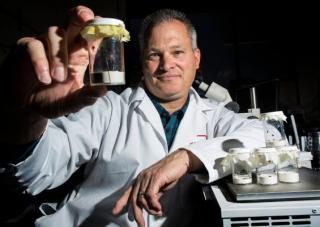With the tick population especially high in Suffolk County this year, officials are holding a series of four forums to help residents stay free of tick bites and the diseases the bugs carry.
“Whether you live in Huntington or Hampton Bays, our goal is to keep residents safe as we enter the final weeks of summer,” County Executive Steve Bellone said in a statement Wednesday.
The Suffolk County Department of Health Services, at Bellone’s direction, is offering an educational campaign to remind the public of health risks associated with ticks, such as Lyme disease, Rocky Mountain spotted fever, babesiosis, and the related illnesses known as anaplasmosis and ehrlichiosis.
Forums are slated for Southampton, Huntington, Brookhaven and Peconic, with the first two being held Monday and Tuesday and the remaining two on Sept. 5.
Suffolk County is home to hundreds of tick-borne illnesses annually and ranks among the most affected regions in New York for illnesses caused by the bugs. The tough-to-spot menaces can bite even in the larval stage and often are no larger than a poppy seed.
Dr. Scott Campbell, chief of the Arthropod-Borne Disease Laboratory in Yaphank, will be the keynote speaker at each forum. Campbell said he will help those who attend better understand ticks and the diseases they carry.
“I will be discussing the medically important tick species, their general biology, the pathogens that they transmit, and how to prevent tick bites,” Campbell said in an interview Wednesday. He added that his talk also will explain how to conduct tick checks and ways of dressing properly in tick territory.
Ticks harbor and transmit multiple types of pathogens — bacteria, viruses and protozoa. The rare Powassan virus has not been detected on Long Island, but was implicated in the June death of a man in upstate Saratoga County, where two other Powassan cases have been reported in recent weeks.
Lyme disease is caused by the widely prevalent bacterial species Borrelia burgdorferi, for which a vaccine is in clinical trials. The infection can be successfully treated with antibiotics.
Still other types of tick-borne bacteria cause Rocky Mountain spotted fever, anaplasmosis and ehrlichiosis. Antibiotics also are used to treat those infections.
Babesiosis, which is prevalent in Suffolk, is caused by an organism known as a protozoan, which causes a malaria-like infection. The pathogen damages red blood cells. Doctors prescribe the same drugs used to treat malaria.
Dr. James Tomarken, Suffolk’s commissioner of health services, said it is “essential for everyone to take appropriate steps to protect themselves from tick-borne diseases. I encourage residents to attend these forums to learn how to stay safe.”
Suffolk officials, in collaboration with the state Department of Health, have established the Tick Surveillance and Management Program, which monitors tick populations and tick-borne pathogens. The program provides municipalities with a range of best practices for dealing with the bugs, which feed on mice and deer.
“Tick-borne illness is a serious health crisis in Suffolk County, particularly on the East End,” said Legis. Bridget Fleming (D-Noyack), who is urging residents to attend the forums.
In addition to tick-borne illnesses, hundreds of people with allergies to red meat have been documented on the East End, a phenomenon that scientists have traced to bites from the Lone Star tick.
Along with the meat-allergy cases centered in the Southampton area, doctors at Stony Brook University Hospital have documented a few cases as well, according to Dr. Saul Hymes, a pediatric infectious disease specialist at Stony Brook. He said children with “alpha-gal” allergy are referred to Stony Brook’s allergists.
Earlier this year, the Suffolk Legislature passed Capital Project 4091, which provides funding to enhance the county Health Department’s Arthropod-Borne Disease Laboratory.
Campbell noted that several tick subspecies — the common deer tick, the Lone Star and American dog tick — thrive in Suffolk County and that the bugs can transmit more than one type of pathogen in a single bite.
Lyme disease is the most common tick-borne infection nationwide, and Suffolk County has been a hot zone of the ailment for decades, experts said.
New York has the highest number of confirmed Lyme disease cases in the country, according to the national Centers for Disease Control and Prevention, which has cataloged more than 95,000 Lyme infections in the state since 1986.
Nationally, about 300,000 cases of Lyme disease are diagnosed annually.
Public forums on tick safety
The Suffolk County Department of Health Services is holding four educational forums on tick prevention and safety. All are scheduled at 7 p.m. and will last about an hour.
Mon., Aug. 21
South Fork Forum, Southampton Town Hall, 116 Route 27A, Southampton
Tues., Aug. 22
Huntington Forum, LaunchPad Huntington, 315 Main St., second floor, Huntington
Tues., Sept. 5
Brookhaven Forum, Middle Country Library, 101 Eastwood Blvd., Centereach
North Fork Forum, Peconic Recreational Center, 1170 Peconic Lane, Peconic
Local numbers on tick-borne illnesses
Suffolk County
Babesiosis
2014 - 204 cases
2015 - 215
2016 - 156
Ehrlichiosis/Anaplasmosis
2014 - 119
2015 - 101
2016 - 123
Lyme disease
2014 - 654
2015 - 669
2016 - 644
Rocky Mountain spotted fever
2014 - 8
2015 - 8
2016 - 13
Powassan virus
2014 - 0
2015 - 0
2016 - 0
Nassau County
Babesiosis
2014 - 9
2015 - 8
2016 - 5
Anaplasmosis*
2014 - 3
2015 - 1
2016 - 4
Ehrlichiosis chafeensis**
2014 - 1
2015 - 0
2016 - 2
Lyme disease
2014 - 25
2015 - 44
2016 - 45
Rocky Mountain spotted fever
2014 - 1
2015 - 1
2016 - 2
Powassan virus
2014 - 0
2015 - 0
2016 - 0
*Anaplasmosis is an infection caused by a parasitic rickettsia-like bacterium. The pathogen is similar to the type that causes ehrlichiosis. Suffolk counts these illneses together. Nassau counts them separately.
**Erlichiosis chafeensis is the full scientific name for the infectious agent transmitted by ticks. The name “chafeensis” comes from Fort Chaffee Maneuver Training Center, the U.S. Army base in Arkansas where the microbe first was isolated.
Sources: Suffolk County Department of Health Services, Nassau County Department of Health

